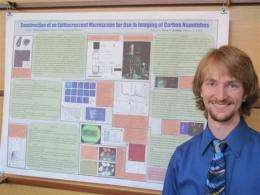Shining light on the elusive carbon nanotube

Michael Blades shakes a small bottle of liquid and watches as tiny black specks swirl around. Each speck represents a cluster of millions of carbon nanotubes (CNTs).
CNTs are rolled sheets of graphene, one of the forms of carbon. They measure just 1 or 2 nanometers in diameter (1nm equals a billionth of a meter), they range in length from 100nm to several centimeters, and they come in a variety of structures.
CNTs have many unique optical, electrical and mechanical properties which make them useful in biological, environmental and other applications.
But their size makes them difficult to detect, examine and manipulate.
Blades, a senior electrical engineering and physics double-major, worked on this problem last summer in a research internship with Lehigh’s Environmental Initiative. He is continuing his study of CNTs this fall with Slava Rotkin, associate professor of physics.
“Carbon nanotubes need to be precisely positioned to function properly,” says Blades. “The problem is, not only are nanotubes very small, they are also very uncooperative.”
A search for the right source of light
Before CNTs can be studied, the clusters must be separated so individual tubes can be observed. Then, light is directed at them. A tube reveals its presence by undergoing photoluminescence and “glowing.”
In his internship, Blades was assigned to assemble an epifluorescent optical microscope capable of viewing CNTs.
He first tried a halogen lamp as a light source.
“When you have a light source, the filament image is superimposed on your sample,” says Blades. “The bright infrared honeycomb pattern that the lamp emitted was too distracting for finding relatively dim nanotubes.”
Next, he switched to a green laser, which caused the nanotubes to give off light in the infrared.
Infrared light is not visible to the naked eye, so Blades turned to a digital camera, which has a charge-coupled device with a wavelength sensitivity greater than the human eye’s.
Removing the infrared filter from a webcam, he aimed it at beads that had been colored with an infrared fluorescent dye. He was on the right track: The beads were visible.
But when he used the webcam to view the fluorescent glow of the CNTs, this did not work because the range of the infrared sensors was insufficient.
A new role for an old camera
The solution turned out to be right at home.
“I had this old [Sony] video camera with an infrared mode called ‘night shot,’” says Blades. “It has a range that extends 200nm farther into the infrared than a normal camera.”
After testing the camera with the microscope, he saw CNT fluorescence “without a doubt.”
But there are still challenges.
“Many things fluoresce when you shine intense light on them,” says Blades, including dust and even the microscope stage on which samples are placed. Vibrations can cause the stage to shake, moving the sample. Also, the light source appears dimmer with certain solutions. Blades cannot identify individual tubes yet, but he’s working to eliminate variables.
Rotkin praises Blades for his creativity.
“Michael is extremely inventive,” he says. “There were obstacles, but he circled them with unusual solutions.”
“It’s been a lot of fun doing this,” says Blades. “I like to get my hands dirty.”
Provided by Lehigh University


















